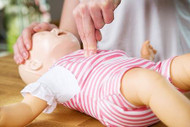What to Do If Your Baby or Toddler Is Choking
Nov 8th 2024
Choking is the last thing any parent wants to think about, but it’s one of the most important things to prepare for. This step-by-step guide will help you identify choking in babies and toddlers, and explain what to do in such an emergency. We also talk about the lifesaving Dechoker device and why it should be a part of your first-aid kit.
Identifying Choking
Although household items can sometimes get caught in kids’ airways, food is the most common hazard for toddlers and even infants. If you believe your child is choking, do the following:
- Determine whether the child is coughing or gagging. This typically means there is only partial blockage of the airway, and it’s best for the child to continue coughing to dislodge the object. If the child is unable to cough, speak or cry, it’s time to act.
- If the child is old enough to understand, ask, “Are you choking?” If they say yes or are unable to reply, take action.
- Call 911, or ideally have someone else call. Time is of the essence once kids begin choking and cannot get air.
What To Do For Choking Infants & Babies
- Turn the baby face-down over your forearm or lap, with the head lower than the chest. Use one hand to support the head under the jaw. Use the heel of your other hand to deliver five quick slaps between the shoulder blades.
- If that does not work, turn the baby over and keep his or her head below the chest. Then place two fingers against the chest and thrust five times.
- Repeat this process of back and chest thrusts until the object is free.
What To Do For Choking Toddlers & Children Older Than 1
- For a choking toddler or child older than 1 who can stand, you should stand or kneel behind the child and wrap your arms around his or her chest. Make a fist below the rib cage and above the navel, and thrust quickly toward yourself, inward and upward.
- Alternate these abdominal thrusts with back blows between the shoulder blades to dislodge the object.
- If the child becomes unresponsive, begin CPR.
Another Option: The Dechoker
In addition to these traditional choking treatments, we believe every family should have access to a lifesaving Dechoker device. Designed in sizes for toddlers, children and adults, the Dechoker is an easy-to-use suction device that uses air to dislodge an object blocking an airway. If your baby is choking, apply the Dechoker first-aid device to the child’s mouth and pull back on the plunger. In many cases, the airway is clear within just seconds.
Common choking treatments such as abdominal thrusts and back blows are trusted techniques, but they also come with the risk of injuring the choking victim, even for trained professionals. The Dechoker gives parents an additional option for ensuring their children’s safety.
Learn more about the how lifesaving Dechoker device works here.
What To Do After a Choking Emergency
If your child had a minor choking incident and was able to cough up the object on his or her own, there isn’t typically a need to seek further care. However, after any major choking emergency, it’s wise to seek out professional medical care. If emergency response personnel have arrived, let them check the child, or visit a doctor or ER. This is particularly important if the child has ongoing coughing, wheezing, drooling or trouble swallowing.
Choking emergencies can be very scary for a family, but prevention and preparedness bring peace of mind. Use this opportunity to educate all children and other members of your family about common choking hazards, choking signs, and treatment methods such as the lifesaving Dechoker device specifically made for choking emergencies.

